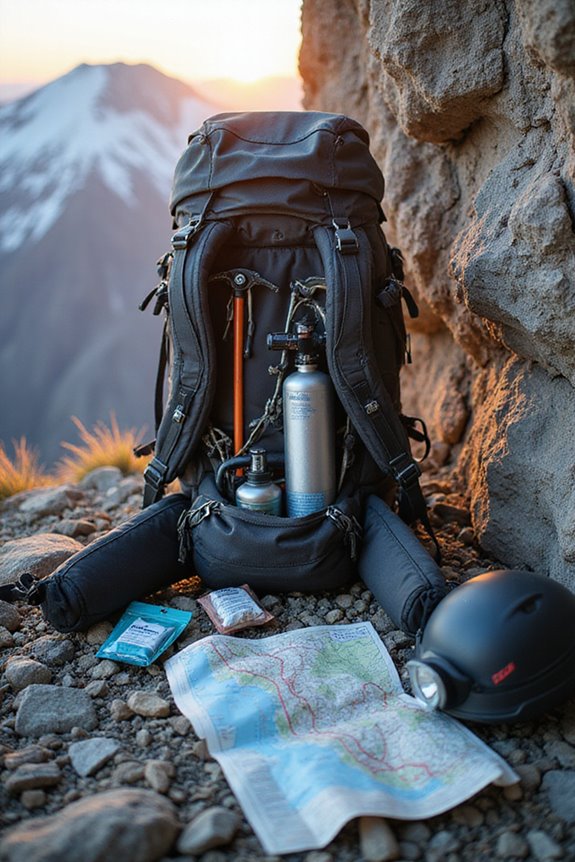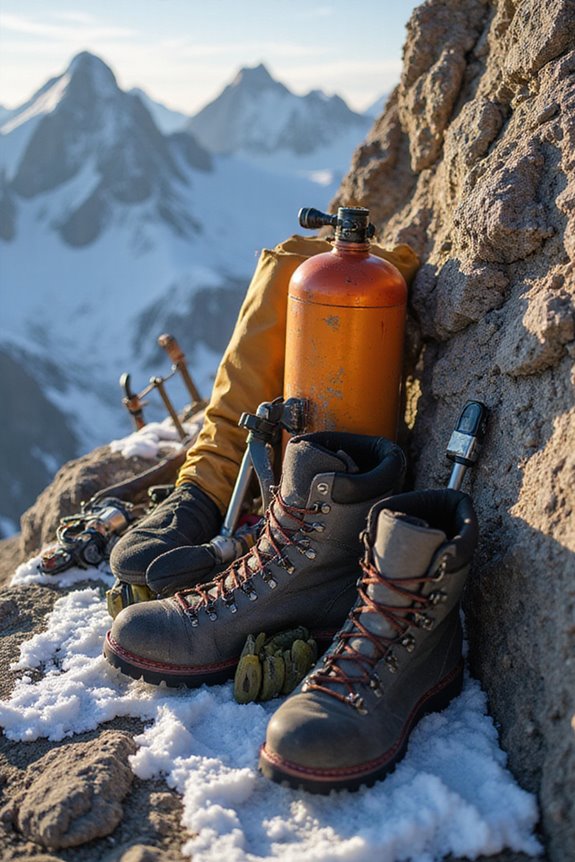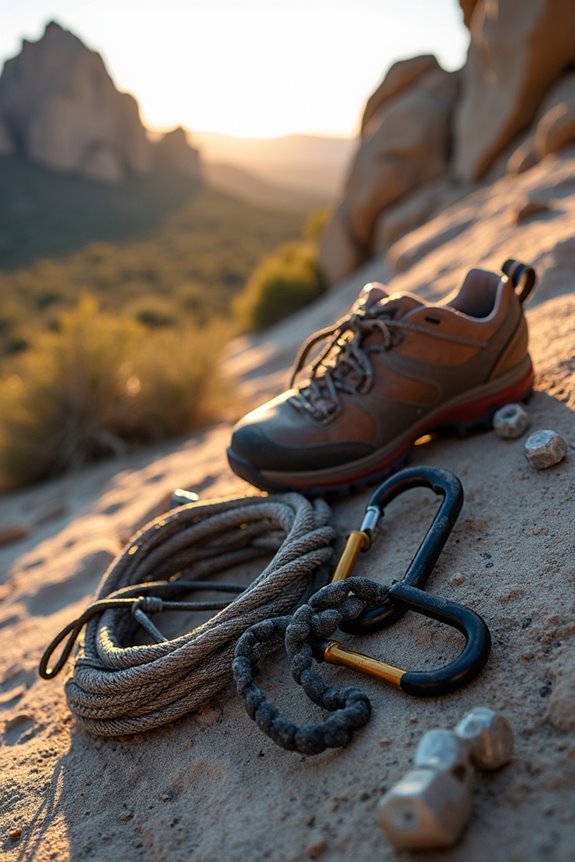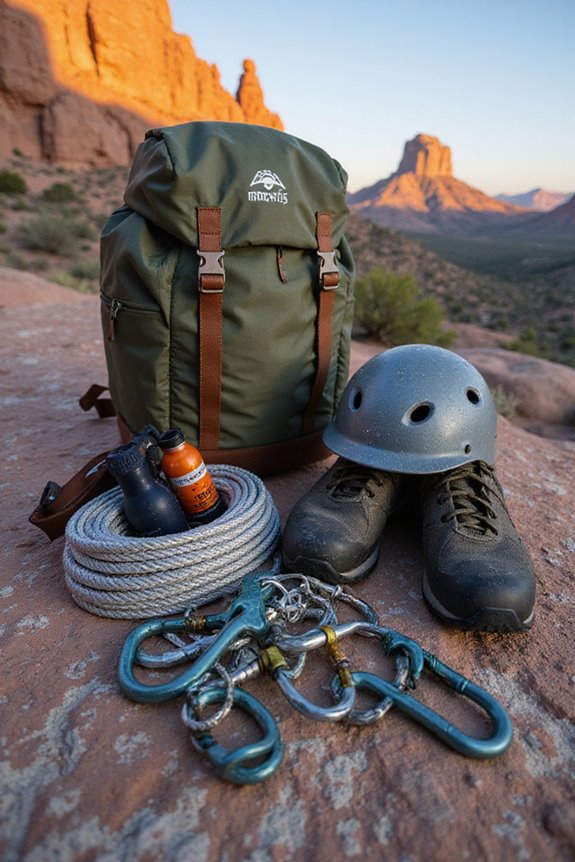When we gear up for high altitude climbing, it’s all about packing smart! We need lightweight helmets, comfy harnesses, warm gloves, and trusty trekking poles. Don’t forget ice axes, locking carabiners, and a solid GPS device for navigation. Layering is key! Moisture-wicking base layers, insulated jackets, and weatherproof outer layers are non-negotiables. Plus, let’s pack a survival kit and emergency signaling devices—safety first! Stick with us, and we’ll reveal even more essential tips for your mountain adventure!
Key Takeaways
- Pack a lightweight helmet and comfortable harness to ensure safety and support during high-altitude climbs.
- Include moisture-wicking base layers and weatherproof outer layers to maintain warmth and dryness in extreme conditions.
- Carry essential navigation tools like a GPS device and baseplate compass for accurate route tracking and orientation.
- Bring technical gear such as ice axes, locking carabiners, and dynamic climbing ropes for safe navigation on challenging terrain.
- Don’t forget an emergency signaling device and a comprehensive survival kit to ensure communication and safety in case of emergencies.
Essential Climbing Equipment
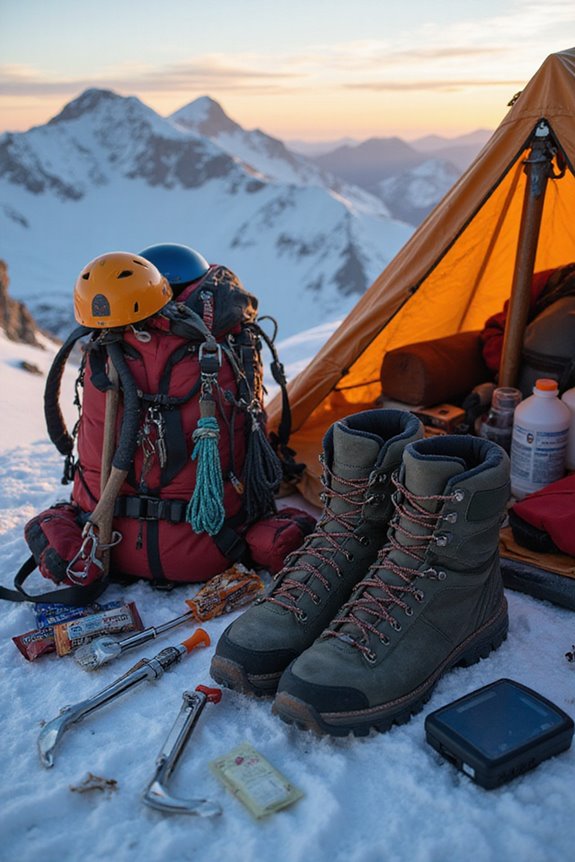
When it comes to high altitude climbing, the right gear is your best friend — think of it as your trusty sidekick on the adventure! We all know that protective and supportive accessories are essential. A lightweight helmet can be a lifesaver, and a comfortable harness is vital when we’re mastering those climbing techniques. Don’t forget warm gloves for those frigid grips! Black Diamond trekking poles provide crucial stability and support when navigating rocky inclines during high altitude expeditions.
We should also keep our gear well-maintained. A well-packed climbing bag, around 3000 cubic inches, means we’ll have what we need, when we need it. Plus, the Camelback hydration system makes staying hydrated super easy. Remember, the mountains may be calling, but with the right equipment, we’ll conquer them together! Ready to scale new heights?
Technical Gear and Accessories
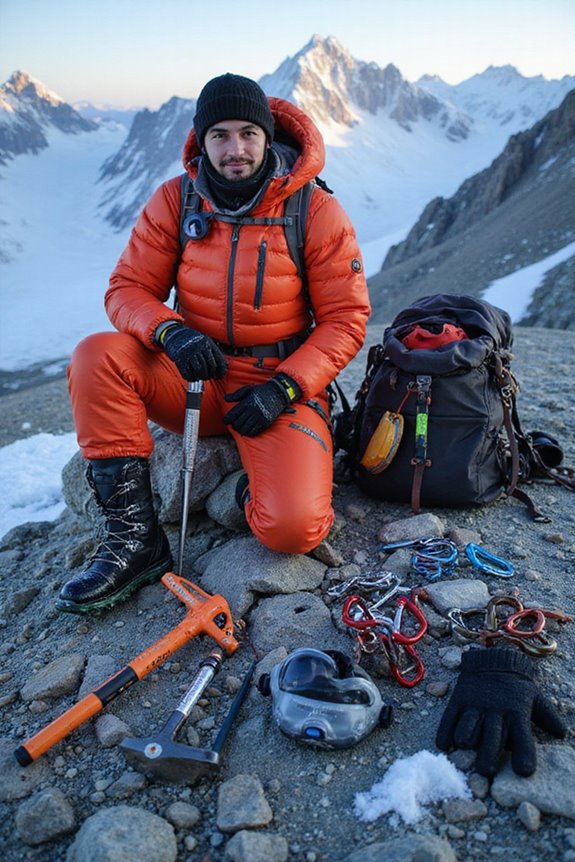
As we gear up for high altitude climbing, having the right technical gear and accessories is absolutely non-negotiable! Ice axes with leashes are our best friends on icy terrain, providing the grip we need when the slopes get steep. Don’t forget climbing harnesses with adjustable leg loops—they keep us secure and comfy for those long ascents and crazy descents. We’ll need ice screws for anchoring ourselves safely during technical climbs and a collection of locking carabiners for securing our ropes like pros. And let’s not overlook pulleys and prusik cords for our crevasse rescue plans! High-quality rubber tip trekking poles offer excellent traction and shock absorption properties to reduce joint strain during the approach hike. With the right gear, we’ll conquer those peaks and embrace the exhilarating freedom of the mountains together. Let’s do this!
Navigation Tools
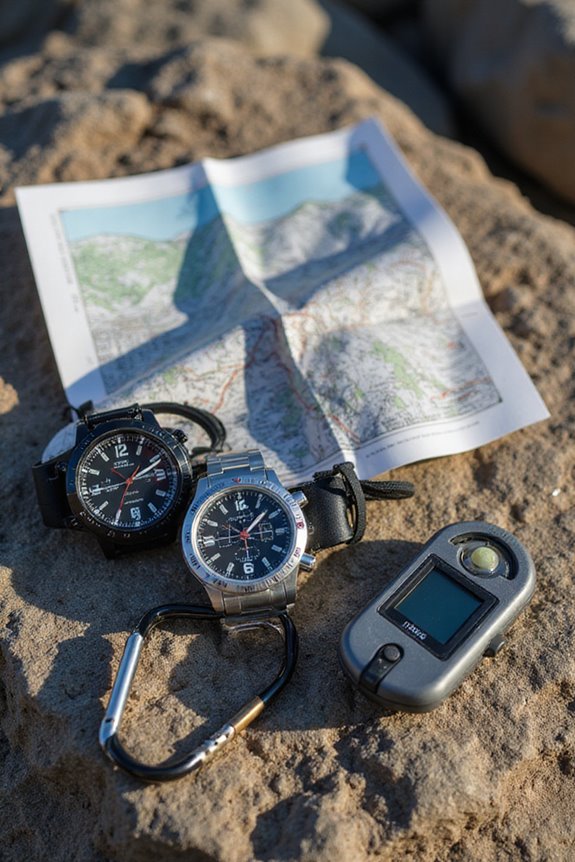
Charting the majestic heights of our favorite mountain ranges can feel like commencing on a thrilling treasure hunt! To navigate these breathtaking domains, we absolutely need reliable tools. GPS devices like the Garmin inReach Explorer+ or Suunto Traverse Alpha keep us on course with precise tracking and emergency communication. But hey, let’s not forget traditional maps! Those rugged topographic beauties are handy for backup and route awareness. When selecting a GPS device, prioritize models with sunlight-readable displays that enhance visibility during your high-altitude adventures. We suggest packing a trusty baseplate compass and an altimeter as well. They help anchor our position when the digital world goes haywire. Embracing both modern tech and classic navigation lets us roam free, knowing we’re equipped for whatever Mother Nature throws our way! Adventure awaits—let’s get climbing!
Clothing and Personal Protection
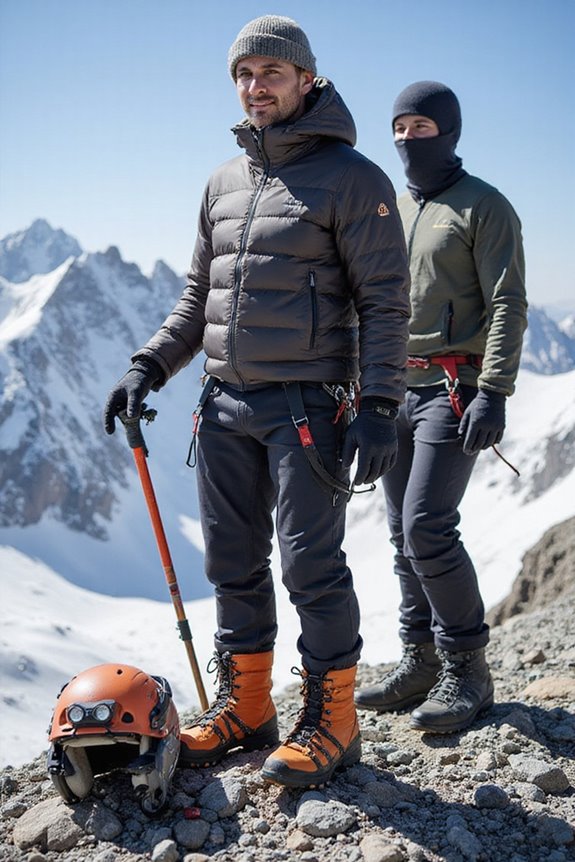
Venturing into the high-altitude wonderlands means we can’t overlook what we wear! Embracing smart layering strategies is key for our comfort. We’ll want moisture-wicking base layers, preferably wool or synthetic, to keep us dry and warm. Ditch cotton; it’s a trap! For our mid-layers, think fleece or down jackets to combat that pesky chill.
Weatherproof outer layers like Gore-Tex keep us shielded from unexpected storms, while ventilation options help us regulate body heat—no one likes feeling like a soggy sponge! Don’t forget our heads and hands; insulated gloves and goggles are essential. For heavy rain protection, choose jackets with waterproof ratings above 10,000mm to ensure you stay completely dry during your climb. With this combo, we’ll conquer those peaks feeling free and protected, ready for adventure without restrictions! Let’s gear up, and let freedom ring!
Safety and Rescue Equipment
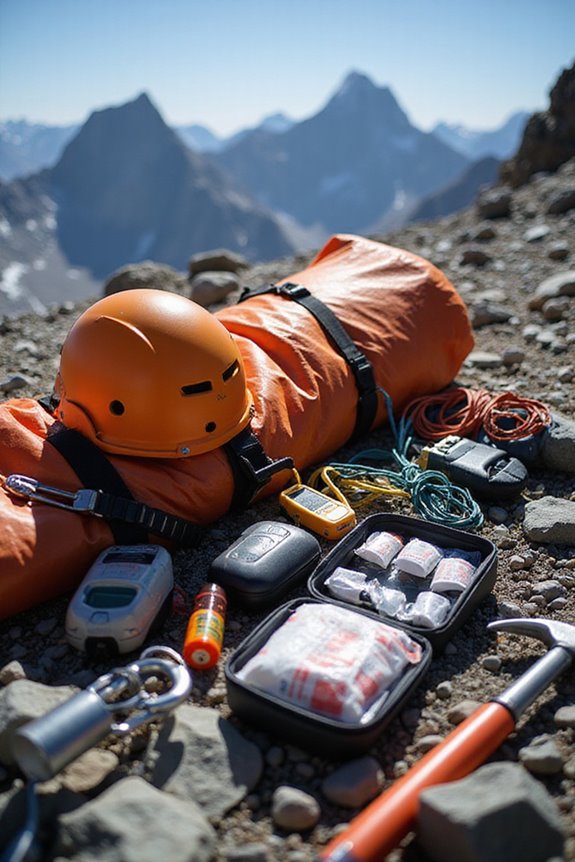
When we’re scaling those lofty peaks, having the right safety and rescue equipment can mean the difference between a thrilling adventure and a serious predicament. We don’t just want to make it to the summit; we want to return safely! That’s where our emergency signaling devices come in—think two-way radios, whistles on lanyards, and signal mirrors. They let us communicate across vast distances or flag down rescuers if needed. A comprehensive survival kit (142 Pcs) with first aid supplies and multi-tools should be part of your essential gear for high altitude climbing. Now, about our rescue gear essentials: dynamic climbing ropes, locking carabiners, and glacier travel systems guarantee that we can navigate tricky terrain and rescue our buddies if they falter. Let’s gear up and embrace the heights while staying ready for anything! Adventure awaits, and safety is our silent partner.
Frequently Asked Questions
What Should I Eat Before and During the Climb?
Before and during our climb, let’s focus on nutrition tips like high-carb meals and energy snacks. We’ll enjoy easy-to-digest foods and hydrate well, ensuring we’re fueled for every exhilarating moment. Let’s conquer those peaks!
How Can I Prevent Altitude Sickness Effectively?
To effectively prevent altitude sickness, we must focus on altitude acclimatization techniques and symptoms recognition. By gradually ascending and monitoring our bodies, we can embrace the freedom of high-altitude adventures while minimizing risks.
What Are the Best Hydration Practices for High Altitudes?
When tackling hydration techniques at high altitudes, we must guarantee electrolyte balance is prioritized. Regularly sipping on electrolyte-rich drinks keeps us hydrated and energized, freeing us to enjoy our adventure without the burden of dehydration.
How Do I Choose the Right Climbing Partner?
Choosing the right climbing partner’s like finding a compass; trust factors and skill levels must align. We’ve learned that teamwork enhances our freedom, making every ascent not just a challenge, but a shared adventure we cherish.
What Permits Do I Need for High-Altitude Climbing?
When it comes to high-altitude climbing, we need to take into account various permit types and navigate the application process. Let’s make sure we’re well-prepared to enjoy the freedom of our climbing adventures without any obstacles.

